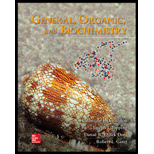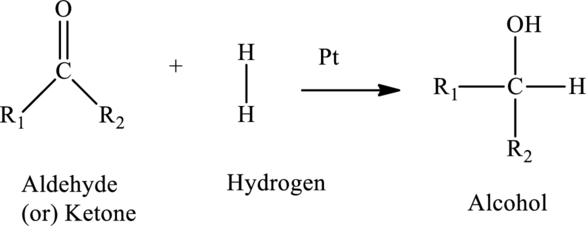
GENERAL ORGANIC+BIOCHEM.-ACCESS>CUSTOM<
10th Edition
ISBN: 9781265799274
Author: Denniston
Publisher: MCG CUSTOM
expand_more
expand_more
format_list_bulleted
Question
Chapter 13, Problem 13.65QP
(a)
Interpretation Introduction
Interpretation:
The hydrogenation reaction of butanal has to be written.
Concept Introduction:
Hydrogenation is the method of reducing an
The hydrogenation of aldehyde produces a primary alcohol.
The general reaction is,

(b)
Interpretation Introduction
Interpretation:
The hydrogenation reaction of
Concept Introduction:
Refer to part (a).
(c)
Interpretation Introduction
Interpretation:
The hydrogenation reaction of
Concept Introduction:
Refer to part (a).
Expert Solution & Answer
Want to see the full answer?
Check out a sample textbook solution
Students have asked these similar questions
Lab Data
The distance entered is out of the expected range.
Check your calculations and conversion factors.
Verify your distance. Will the gas cloud be closer to the cotton ball with HCI or NH3?
Did you report your data to the correct number of significant figures?
- X
Experimental Set-up
HCI-NH3
NH3-HCI
Longer Tube
Time elapsed (min)
5 (exact)
5 (exact)
Distance between cotton balls (cm)
24.30
24.40
Distance to cloud (cm)
9.70
14.16
Distance traveled by HCI (cm)
9.70
9.80
Distance traveled by NH3 (cm)
14.60
14.50
Diffusion rate of HCI (cm/hr)
116
118
Diffusion rate of NH3 (cm/hr)
175.2
175.2
How to measure distance and calculate rate
For the titration of a divalent metal ion (M2+) with EDTA, the stoichiometry of the reaction is typically:
1:1 (one mole of EDTA per mole of metal ion)
2:1 (two moles of EDTA per mole of metal ion)
1:2 (one mole of EDTA per two moles of metal ion)
None of the above
Please help me solve this reaction.
Chapter 13 Solutions
GENERAL ORGANIC+BIOCHEM.-ACCESS>CUSTOM<
Ch. 13.1 - Which member in each of the following pairs will...Ch. 13.1 - Which member in each of the following pairs will...Ch. 13.1 - Prob. 13.3QCh. 13.1 - Prob. 13.4QCh. 13.2 - Prob. 13.1PPCh. 13.2 - Prob. 13.2PPCh. 13.2 - Prob. 13.3PPCh. 13.2 - Prob. 13.4PPCh. 13.2 - Prob. 13.5QCh. 13.2 - Write the condensed formula for each of the...
Ch. 13.2 - Prob. 13.7QCh. 13.2 - Write the condensed formula for each of the...Ch. 13.3 - Draw the structure of the aldehyde synthesized...Ch. 13.3 - Prob. 13.10QCh. 13.4 - Prob. 13.5PPCh. 13.4 - Prob. 13.6PPCh. 13.4 - Prob. 13.7PPCh. 13.4 - Prob. 13.8PPCh. 13.4 - Prob. 13.11QCh. 13.4 - Prob. 13.12QCh. 13.4 - Identify each of the following structures as a...Ch. 13.4 - Identify each of the following structures as a...Ch. 13.4 - Prob. 13.9PPCh. 13 - Prob. 13.15QPCh. 13 - Prob. 13.16QPCh. 13 - Prob. 13.17QPCh. 13 - Prob. 13.18QPCh. 13 - Prob. 13.19QPCh. 13 - Prob. 13.20QPCh. 13 - Prob. 13.21QPCh. 13 - Why do hydrocarbons have lower boiling points than...Ch. 13 - Prob. 13.23QPCh. 13 - Prob. 13.24QPCh. 13 - Prob. 13.25QPCh. 13 - Prob. 13.26QPCh. 13 - Prob. 13.27QPCh. 13 - Prob. 13.28QPCh. 13 - Draw each of the following using condensed...Ch. 13 - Prob. 13.30QPCh. 13 - Prob. 13.31QPCh. 13 - Prob. 13.32QPCh. 13 - Prob. 13.33QPCh. 13 - Prob. 13.34QPCh. 13 - Prob. 13.35QPCh. 13 - Prob. 13.36QPCh. 13 - Prob. 13.37QPCh. 13 - Prob. 13.38QPCh. 13 - Give the IUPAC name for each of the following...Ch. 13 - Give the IUPAC name for each of the following...Ch. 13 - Prob. 13.41QPCh. 13 - Prob. 13.42QPCh. 13 - Prob. 13.43QPCh. 13 - Prob. 13.44QPCh. 13 - Prob. 13.45QPCh. 13 - Prob. 13.46QPCh. 13 - Prob. 13.47QPCh. 13 - Prob. 13.48QPCh. 13 - Prob. 13.49QPCh. 13 - Prob. 13.50QPCh. 13 - Prob. 13.51QPCh. 13 - Prob. 13.52QPCh. 13 - Prob. 13.53QPCh. 13 - Prob. 13.54QPCh. 13 - Prob. 13.55QPCh. 13 - Prob. 13.56QPCh. 13 - Prob. 13.57QPCh. 13 - Prob. 13.58QPCh. 13 - Prob. 13.59QPCh. 13 - Prob. 13.60QPCh. 13 - Prob. 13.61QPCh. 13 - An unknown has been determined to be one of the...Ch. 13 - Prob. 13.63QPCh. 13 - Prob. 13.64QPCh. 13 - Prob. 13.65QPCh. 13 - Prob. 13.66QPCh. 13 - Which of the following compounds would be expected...Ch. 13 - Write an equation representing the reaction of...Ch. 13 - Prob. 13.69QPCh. 13 - Prob. 13.70QPCh. 13 - Prob. 13.71QPCh. 13 - Prob. 13.72QPCh. 13 - Prob. 13.73QPCh. 13 - Prob. 13.74QPCh. 13 - Prob. 13.75QPCh. 13 - Prob. 13.76QPCh. 13 - Prob. 13.77QPCh. 13 - Prob. 13.78QPCh. 13 - Prob. 13.79QPCh. 13 - Prob. 13.80QPCh. 13 - Prob. 13.81QPCh. 13 - Prob. 13.82QPCh. 13 - Prob. 13.83QPCh. 13 - Prob. 13.84QPCh. 13 - Prob. 1MCPCh. 13 - Prob. 2MCPCh. 13 - Prob. 3MCPCh. 13 - Prob. 4MCPCh. 13 - Prob. 6MCPCh. 13 - Prob. 7MCPCh. 13 - Prob. 8MCPCh. 13 - Design a synthesis for each of the following...Ch. 13 - Prob. 10MCPCh. 13 - Prob. 12MCP
Knowledge Booster
Similar questions
- Indicate the products obtained by mixing 2,2-dimethylpropanal with acetaldehyde and sodium ethoxide in ethanol.arrow_forwardSynthesize 2-Ethyl-3-methyloxirane from dimethyl(propyl)sulfonium iodide using the necessary organic or inorganic reagents. Draw the structures of the compounds.arrow_forwardSynthesize 2-Hydroxy-2-phenylacetonitrile from phenylmethanol using the necessary organic or inorganic reagents. Draw the structures of the compounds.arrow_forward
- Synthesize N-Methylcyclohexylamine from cyclohexanol using the necessary organic or inorganic reagents. Draw the structures of the compounds.arrow_forwardSynthesize N-Methylcyclohexylamine from cyclohexanol using the necessary organic or inorganic reagents. Draw the structures of the compounds.arrow_forwardIf possible, please provide the formula of the compound 3,3-dimethylbut-2-enal.arrow_forward
- Synthesize 1,4-dibromobenzene from acetanilide (N-phenylacetamide) using the necessary organic or inorganic reagents. Draw the structures of the compounds.arrow_forwardIndicate the products obtained by mixing (3-oxo-3-phenylpropyl)triphenylphosphonium bromide with sodium hydride.arrow_forwardWe mix N-ethyl-2-hexanamine with excess methyl iodide and followed by heating with aqueous Ag2O. Indicate the major products obtained.arrow_forward
- Indicate the products obtained by mixing acetophenone with iodine and NaOH.arrow_forwardIndicate the products obtained by mixing 2-Propanone and ethyllithium and performing a subsequent acid hydrolysis.arrow_forwardIndicate the products obtained if (E)-2-butenal and 3-oxo-butanenitrile are mixed with sodium ethoxide in ethanol.arrow_forward
arrow_back_ios
SEE MORE QUESTIONS
arrow_forward_ios
Recommended textbooks for you
 ChemistryChemistryISBN:9781305957404Author:Steven S. Zumdahl, Susan A. Zumdahl, Donald J. DeCostePublisher:Cengage Learning
ChemistryChemistryISBN:9781305957404Author:Steven S. Zumdahl, Susan A. Zumdahl, Donald J. DeCostePublisher:Cengage Learning ChemistryChemistryISBN:9781259911156Author:Raymond Chang Dr., Jason Overby ProfessorPublisher:McGraw-Hill Education
ChemistryChemistryISBN:9781259911156Author:Raymond Chang Dr., Jason Overby ProfessorPublisher:McGraw-Hill Education Principles of Instrumental AnalysisChemistryISBN:9781305577213Author:Douglas A. Skoog, F. James Holler, Stanley R. CrouchPublisher:Cengage Learning
Principles of Instrumental AnalysisChemistryISBN:9781305577213Author:Douglas A. Skoog, F. James Holler, Stanley R. CrouchPublisher:Cengage Learning Organic ChemistryChemistryISBN:9780078021558Author:Janice Gorzynski Smith Dr.Publisher:McGraw-Hill Education
Organic ChemistryChemistryISBN:9780078021558Author:Janice Gorzynski Smith Dr.Publisher:McGraw-Hill Education Chemistry: Principles and ReactionsChemistryISBN:9781305079373Author:William L. Masterton, Cecile N. HurleyPublisher:Cengage Learning
Chemistry: Principles and ReactionsChemistryISBN:9781305079373Author:William L. Masterton, Cecile N. HurleyPublisher:Cengage Learning Elementary Principles of Chemical Processes, Bind...ChemistryISBN:9781118431221Author:Richard M. Felder, Ronald W. Rousseau, Lisa G. BullardPublisher:WILEY
Elementary Principles of Chemical Processes, Bind...ChemistryISBN:9781118431221Author:Richard M. Felder, Ronald W. Rousseau, Lisa G. BullardPublisher:WILEY

Chemistry
Chemistry
ISBN:9781305957404
Author:Steven S. Zumdahl, Susan A. Zumdahl, Donald J. DeCoste
Publisher:Cengage Learning

Chemistry
Chemistry
ISBN:9781259911156
Author:Raymond Chang Dr., Jason Overby Professor
Publisher:McGraw-Hill Education

Principles of Instrumental Analysis
Chemistry
ISBN:9781305577213
Author:Douglas A. Skoog, F. James Holler, Stanley R. Crouch
Publisher:Cengage Learning

Organic Chemistry
Chemistry
ISBN:9780078021558
Author:Janice Gorzynski Smith Dr.
Publisher:McGraw-Hill Education

Chemistry: Principles and Reactions
Chemistry
ISBN:9781305079373
Author:William L. Masterton, Cecile N. Hurley
Publisher:Cengage Learning

Elementary Principles of Chemical Processes, Bind...
Chemistry
ISBN:9781118431221
Author:Richard M. Felder, Ronald W. Rousseau, Lisa G. Bullard
Publisher:WILEY